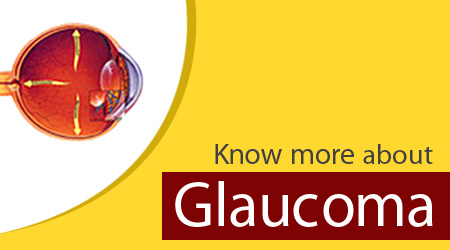Glaucoma – The Silent Thief Of Vision
HAVE YOU SEEN ANY OF THESE SYMPTOMS IN YOU OR ANY OF YOUR FAMILY MEMBERS?
- Difficulty seeing at night.
- Intermittent blurring of vision
- Frequent change of glasses.
- Loss of field of vision
If yes, read this blog to get all information about Glaucoma, its symptoms, its treatment and how to get diagnosed and detected.
Glaucoma is a disease that can take your vision away. In India, one out of every 50 patients has lost their eyesight due to glaucoma. One of every seven patients of glaucoma is totally blind before they reach the hospital for glaucoma treatment. The most disturbing fact is that this blindness is needless and preventable. Awareness, careful examination and adhering to the prescribed treatment can prevent blindness due to glaucoma.
QUESTIONS ANSWERED IN THIS ARTICLE:
- What is glaucoma?
- What are the possible symptoms of glaucoma?
- Types of glaucoma
- How can glaucoma be diagnosed and detected?
- How can glaucoma be treated after diagnosis?
- Conclusion
WHAT IS GLAUCOMA?
Glaucoma is a disease caused by poor nutrition and oxygenation of the optic nerve. When the balance of the liquid that enters and exits the eyes is disrupted due to a blockage, it causes an increase of pressure in the eye which eventually damages the optic nerve.
The optic nerve sends messages to your brain, allowing you to have sharp central and peripheral vision. When this nerve is damaged, it causes holes and gaps in vision. Unfortunately, these holes are rarely noticed and these gaps in vision can progress to full blindness if left unnoticed and untreated.
Unlike cataract, the loss of sight is permanent and irrecoverable. Fortunately, glaucoma can be prevented if it is diagnosed and treated early. Regular examination of the eyes at an eye hospital is extremely important for people over 40 years of age or a family history of glaucoma.
WHAT ARE POSSIBLE SYMPTOMS OF GLAUCOMA?
- Having a possible history of glaucoma in the family.
- Intermittent blurring of vision
- Loss of field of vision
- Difficulty seeing at night.
- Frequent change of glasses.
- Seeing coloured haloes around light.
TYPES OF GLAUCOMA
There are four types of glaucoma:
1. Open Angle Glaucoma:
This is the most dangerous type of glaucoma as the rise in pressure is gradual and often unnoticed. The pressure in the eye increases very gradually which causes the eye to get acclimated to the new pressure. This type of glaucoma can take away vision so quietly that often the patient doesn’t know that something is wrong until significant damage has occurred to the optic nerve. The only way to prevent this type of glaucoma is frequent eye examinations by competent specialists and early diagnosis. Often patients of this glaucoma may complain of frequent change of glasses.
2. Angle closure Glaucoma:
This type of glaucoma is caused by a sudden increase in pressure inside the eye. Blurred vision, severe pain, rainbow halos around light, nausea and vomiting are possible symptoms. These patients should be brought to an eye specialist at the earliest.
3. Congenital glaucoma:
This type of glaucoma is caused by poorly formed drainage channels at the time of birth. The child’s eyes increase in size due to the rise in pressure inside the eye. The front portion of the eyes increase in size and the eye can gain a bluish hue (Bull’s eye). These children should be taken to an eye centre as soon as possible.
4. Secondary glaucoma:
Any injury, drugs like steroids, tumours, bleeding, inflammation etc can sometimes block the outflow channels. This can lead to increased pressure and is called secondary glaucoma.
HOW CAN GLAUCOMA BE DETECTED AND DIAGNOSED?
Early diagnosis is of utmost importance to prevent total loss of vision. Generally, glaucoma can occur in adults above 40 years old and above and with a family history of glaucoma. Patients who fall in these categories should have regular eye checkups. The common type of glaucoma is Open Angle Glaucoma which is largely asymptomatic so eye checkups can help provide and early diagnosis and therefore an earlier treatment.More information about the tools used here.
HOW CAN GLAUCOMA BE TREATED AFTER DIAGNOSIS?
The patient needs to follow the prescribed treatment exactly to prevent further deterioration of vision. Glaucoma can be treated with drugs, laser or by surgery. The regular use of eye drops and maintenance of proper periodicity of the drug is very important. These medicines either reduce the aqueous formation or improve the drainage channels. Surgery and laser are used to create artificial channels if the drugs fail to achieve target pressure. Complications of modern glaucoma surgery are rare.
CONCLUSION:
Unlike cataract, the blindness caused by glaucoma is permanent and irreversible. Prevention is better than the cure, so the key is to consult your eye specialist periodically for glaucoma, especially if you are 40 years of age or above or if you are experiencing any possible symptoms of glaucoma. Your doctor can help you preserve your vision and we can provide you with the best services in one of the best eye hospitals in Pune. Please visit NIO-Multi Speciality Eye Hospital in Aundh,Pune regularly to get your eyes checked thoroughly by our competent eye specialists. Please call at: 020 4901 4901 / 020 41460100 to book an appointment or contact us to book an online appointment on website: www.nioeyes.com
nioclinic’s blog
Dr. Pankaj Bendale
(M.B.B.S , MS (Ophth))
Get advice from our expert ophthalmologist at NIO Eye Clinic Aundh, Pune on any eye health-related issue such as cataract surgery, glaucoma treatment, child eye care, refractive surgery, low vision and more. It is in your best interest to consult an eye specialist in person for immediate treatment. Simply fill up the form below and we will reach out to you soon



